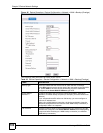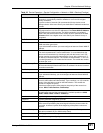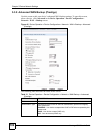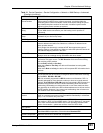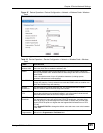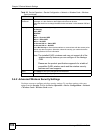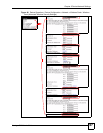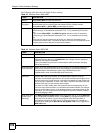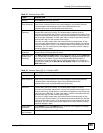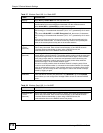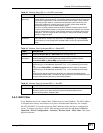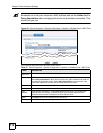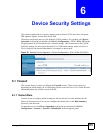
Chapter 5 Device Network Settings
Vantage CNM User’s Guide
108
The following table describes the fields in these settings.
Table 33 Wireless Card: Static WEP
LABEL DESCRIPTION
Security Select Static WEP from the drop-down list.
WEP
Encryption
WEP (Wired Equivalent Privacy) provides data encryption to prevent unauthorized
wireless stations from accessing data transmitted over the wireless network.
Select 64-bit WEP or 128-bit WEP to enable data encryption.
Key 1 to Key 4 If you chose 64-bit WEP in the WEP Encryption field, then enter any 5 characters
(ASCII string) or 10 hexadecimal characters ("0-9", "A-F") preceded by 0x for each
key.
If you chose 128-bit WEP in the WEP Encryption field, then enter 13 characters
(ASCII string) or 26 hexadecimal characters ("0-9", "A-F") preceded by 0x for each
key.
There are four data encryption keys to secure your data from eavesdropping by
unauthorized wireless users. The values for the keys must be set up exactly the same
on the access points as they are on the wireless stations.
Table 34 Wireless Card: WPA-PSK
LABEL DESCRIPTION
Security Select WPA-PSK from the drop-down list.
Pre-Shared Key The encryption mechanisms used for WPA and WPA-PSK are the same. The only
difference between the two is that WPA-PSK uses a simple common password,
instead of user-specific credentials.
Type a pre-shared key from 8 to 63 case-sensitive ASCII characters (including
spaces and symbols).
ReAuthentication
Timer (Seconds)
Specify how often wireless stations have to resend user names and passwords in
order to stay connected. Enter a time interval between 10 and 65535 seconds.
If wireless station authentication is done using a RADIUS server, the
reauthentication timer on the RADIUS server has priority.
Idle Timeout
(Seconds)
The Vantage CNM automatically disconnects a wireless station from the wireless
network after a period of inactivity. The wireless station needs to send the
username and password again before it can use the wireless network again. Some
wireless clients may prompt users for a username and password; other clients may
use saved login credentials. In either case, there is usually a short delay while the
wireless client logs in to the wireless network again.
This value is usually smaller when the wireless network is keeping track of how
much time each wireless station is connected to the wireless network (for example,
using an authentication server). If the wireless network is not keeping track of this
information, you can usually set this value higher to reduce the number of delays
caused by logging in again.
WPA Group Key
Update Timer
(Seconds)
The WPA Group Key Update Timer is the rate at which the AP (if using WPA-PSK
key management) or RADIUS server (if using WPA key management) sends a new
group key out to all clients. The re-keying process is the WPA equivalent of
automatically changing the WEP key for an AP and all stations in a WLAN on a
periodic basis. Setting of the WPA Group Key Update Timer is also supported in
WPA-PSK mode.



